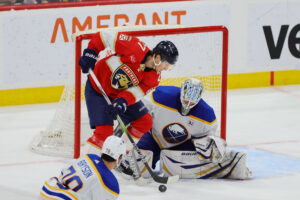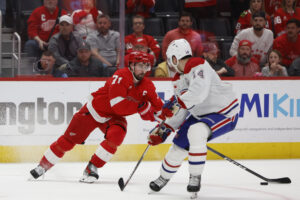The Arizona Coyotes salary cap issues began with the irresponsible and wild contracts that former general manager John Chayka gifted players. During his reign, he bestowed multi-year deals to three players who now have not been at all performing equal to their contracts. Oliver Ekman-Larsson was given an eight-year $66 million deal on July 1, 2018. Then, in March of 2019, Chayka gave Nick Schmaltz a seven-year $40.95 million deal. Last but not least, was Clayton Keller who dotted the line in September of 2019 for a cool eight-year $57.2 million contract. Per capfriendly.com, forward Conor Garland received only $19,871 per point scored last season which was the lowest of any player in the league. Now that’s being grossly underpaid!
Paying $21 Million to Underperforming Players is an Arizona Coyotes Salary Cap Issue
Over the next five years, paying three underperforming players $21 million is just not sustainable. It seems to be the main reason why the Coyotes need to look at losing at least one of the three contracts before the 2021-22 begins. Not that they need more cap space since they will have approximately $31 million to work with attracting better players. It’s more of a matter of getting players who perform at a level equal or exceeding their contracts. Take Conor Garland for example. His return rate on his miniscule $775,000 contract is in direct contrast with the above three mentioned players as far as return is concerned.
OEL Contract Issues
OEL’s play has disintegrated during the Rick Tocchet coaching years and it seems inevitable that he will be dealt. He knows that, and has opened the possibilities of finding a new home. OEL has accepted the fact that his time here in the desert is coming to an end. With that, he has changed his outlook by being more open to accepting a trade from more than two teams this time. That should make the possibility of moving at least a major portion of his huge contract possible. Most any trade partner that is appealed to add OEL to their roster will expect the Yotes to retain a portion of his contract.
It may just be that OEL needs a change of scenery and at the soon to be age of 30, he still has plenty of hockey left in him. There are still rumours that he could go to the Boston Bruins or Vancouver Canucks. Both of those teams need help on the blueline and Boston seems to be a good trading partner for Arizona. As far as Schmidt goes, according to David Pagnotta of thefourthperiod.com, Schmidt is on the trading block.
ICYMI, we came out with our Summer Trade Watch List earlier this week https://t.co/yB3mNM2VsI
— David Pagnotta (@TheFourthPeriod) July 1, 2021
While a trade involving Schmidt for OEL may be attractive, it seems unlikely. IF the Coyotes could somehow get Schmidt, their blueline rebuild would be underway. He can play both sides of the blueline much like Alex Goligoski has done in Arizona. So, it seems more likely that the Canucks want to move Schmidt and his $5.95 million contract through 2024-25 to perhaps revisit the OEL to Vancouver possibilities. If that’s the case, we should know something sooner rather than later.
Schmaltz Contract Issues
His $5.85 AAV contract was awarded to him after being traded from the Chicago Blackhawks for Dylan Strome (#3 overall pick in 2015) and Brendan Perlini. He played all of 17 games in the 2018-19 season before blowing out his knee and sitting out the rest of the year. What Chayka saw in him is still a mystery, especially since Strome played pretty well in Chicago. He has collected 38 goals and 68 assists for 106 points in 156 games. While Schmaltz has similar statistics with 26 goals and 65 assists in 139 games, Strome has a much less expensive cap hit set at just $3 million through next season.
If you go by capfriendly.com (and who doesn’t?) it will show that Schmaltz receives $182,812 per point scored. Strome comes in a bit cheaper at $176,470 per point tallied. The point here is that while Schmaltz is a capable player, he’s not worth $5.85 million per year. The real kicker here is the length of his contract. For some bizarre reason Chayka saw fit to award players with potential as if they were top-25 NHL players. Now, unfortunately for new general manager Bill Armstrong, he has to pick up the pieces that his predecessor left him. It’s got to be a messy job, but Armstrong seems to like the challenge.
Keller Contract Issues
Of the three players listed, Keller’s contract seems to irritate Coyotes’ followers the most. He signed the lucrative deal in September of 2019, but it didn’t take effect until the 2020-21 season. In that inaugural year of his new deal he put up a whole 17 goals and 27 assists in 70 games. You tell me if that’s worth $7.15 million. Hardly. Going back to our compensation per point analogy, Keller was paid a whopping $204,285 per point! See what I mean? If the Coyotes could get rid of this ugly contract by trading Keller while they can, they will be that much better off. He does have a no-trade clause in his contract due to kick in after the 2023-24 campaign.
Does Keller have potential? Of course. Has he shown it yet? Not really. He tends to disappear and not be on the scorecard for multiple games at a time. That may be attributed to him playing the wing instead of his normal centre-ice position. Perhaps with a new coach in Andre Tourigny he will show his pure talent. He does stay healthy playing in every games thus far in Arizona. It seems that GM Armstrong has some tough decisions to make and keeping or trading Keller is certainly one of them. It will of course, depend on the return the Yotes can get for any of these players before a deal is consummated.
In Review, the Coyotes Need to Lose Some Bad Contracts
If the Desert Dogs wish to re-sign their star-to-be Garland as a restricted free agent, they need to be able to have the money to do that. Even with an estimated $31 million in cap space, that could disappear quickly considering the team needs to rebuild their blueline and bring in some more talented free agents or pay newly acquired players in a trade. Players like Dougie Hamilton, Seth Jones, and Nate Schmidt don’t come cheaply. If they do trade OEL, they desperately need more quality players on the blueline to compete in the future.
Another huge need is on offence. If they could land a top centre, the chances of them moving up in the standings will increase exponentially.
Without a doubt, the 2021-22 season will possess some huge challenges for the Coyotes. They will be switching to the Central Division and will see a much higher level of competition most nights. To succeed they need better players. They possess some assets that other teams may be attracted to and they should take advantage of that by acting accordingly. If current roster players are not earning their keep, they’ve got to be replaced.
After all, the NHL is still a business and losing money year in and year out is not a formula for success. The three named players in this article cannot continue to be overpaid. It’s just not sustainable. Of course that’s something former GM Chayka never thought through before he opened up the team’s resources.
Lessons learned, now let’s move on and see what GM Armstrong can actually do about it.
Main Photo:






